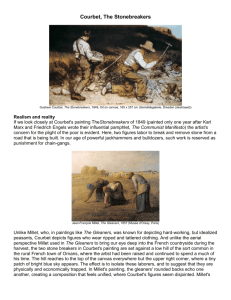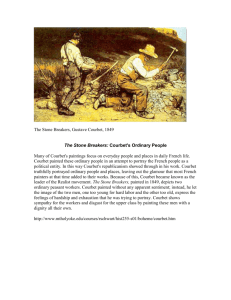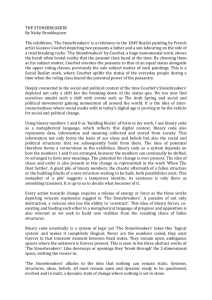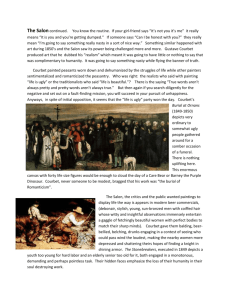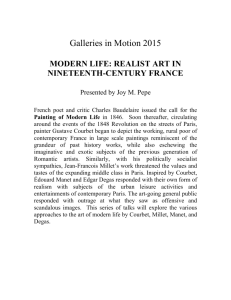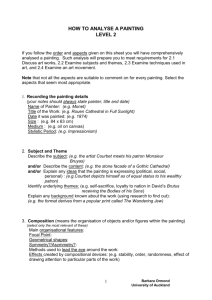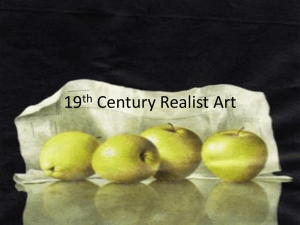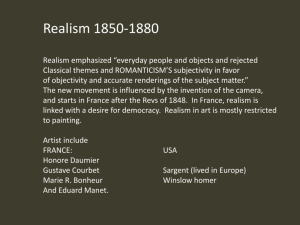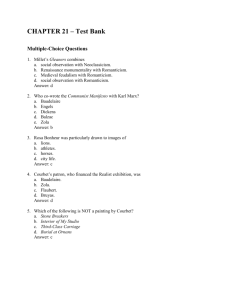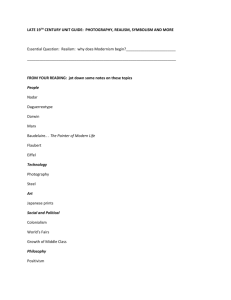Yale_Visual Analysis
advertisement
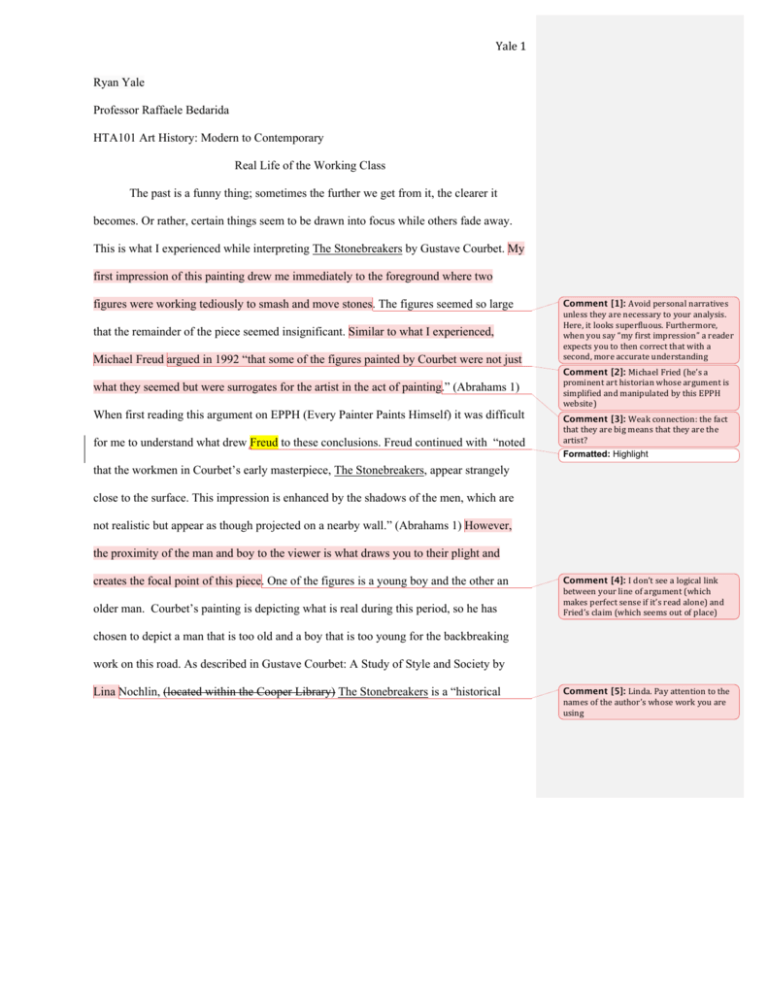
Yale 1 Ryan Yale Professor Raffaele Bedarida HTA101 Art History: Modern to Contemporary Real Life of the Working Class The past is a funny thing; sometimes the further we get from it, the clearer it becomes. Or rather, certain things seem to be drawn into focus while others fade away. This is what I experienced while interpreting The Stonebreakers by Gustave Courbet. My first impression of this painting drew me immediately to the foreground where two figures were working tediously to smash and move stones. The figures seemed so large that the remainder of the piece seemed insignificant. Similar to what I experienced, Michael Freud argued in 1992 “that some of the figures painted by Courbet were not just what they seemed but were surrogates for the artist in the act of painting.” (Abrahams 1) When first reading this argument on EPPH (Every Painter Paints Himself) it was difficult for me to understand what drew Freud to these conclusions. Freud continued with “noted Comment [1]: Avoid personal narratives unless they are necessary to your analysis. Here, it looks superfluous. Furthermore, when you say “my first impression” a reader expects you to then correct that with a second, more accurate understanding Comment [2]: Michael Fried (he’s a prominent art historian whose argument is simplified and manipulated by this EPPH website) Comment [3]: Weak connection: the fact that they are big means that they are the artist? Formatted: Highlight that the workmen in Courbet’s early masterpiece, The Stonebreakers, appear strangely close to the surface. This impression is enhanced by the shadows of the men, which are not realistic but appear as though projected on a nearby wall.” (Abrahams 1) However, the proximity of the man and boy to the viewer is what draws you to their plight and creates the focal point of this piece. One of the figures is a young boy and the other an older man. Courbet’s painting is depicting what is real during this period, so he has Comment [4]: I don’t see a logical link between your line of argument (which makes perfect sense if it’s read alone) and Fried’s claim (which seems out of place) chosen to depict a man that is too old and a boy that is too young for the backbreaking work on this road. As described in Gustave Courbet: A Study of Style and Society by Lina Nochlin, (located within the Cooper Library) The Stonebreakers is a “historical Comment [5]: Linda. Pay attention to the names of the author’s whose work you are using Yale 2 perspective as bringing to a climax the current of sympathetic representations of manual labor”. (Nochlin 147) The age differential between these two figures personally seems to Comment [6]: difference suggest that those who are born poor peasants will remain poor, and will continue to do hard labor from birth to death. Their clothes are tattered and seem to reflect their plight. The colors, not only of their clothes, but also of the entire scene are very muted. I wondered at first whether the picture had faded, but realize that the lack of color likely reflects Courbet’s mood about the scene. The terrible circumstance painted in dull and unappealing color seems very fitting. Looking beyond the focal point, the mountain behind the figures and the road in front are depicted so that it seems as though they surround the man and boy so that they will never be able to leave their life of hard labor since there is nowhere for them to go. Even the small square of blue sky seems to taunt them as to what can never be. The faces of the two figures are obscured within the image and the young boy’s back is almost completely turned to the viewer. This is in direct contrast to the normal attention paid to people painted by conventional artists at this time. Courbet deliberately chose not to depict the workers faces within this image, so as to, draw attention to the poor working conditions and abuse that many peasant workers faced during this time. As described in Gustave Courbet by Gerstle Mack, “The Stonebreakers is a satire on our industrial civilizations, which constantly invents wonderful machines to…. Perform…all kinds of labor…and yet is unable to liberate man from the most backbreaking toil” (Mack 70). The figures within this work seem realistic, and I instantly felt their pain and suffering. I think this is the feeling that Courbet wanted to evoke from the viewers of this time. They are seen not as individuals but rather are just a source of labor, regardless of their age. Looking beyond the foreground figures, I noticed that there Comment [7]: but he claims that he depicts things the way they are: so he would not like the idea of filtering images through his own mood. I don’t say that everything artists declare is necessarily true but it should be at least acknowledged. Yale 3 are a few carefully chosen personal belongings consisting of a basket and some tools that are slightly cropped out of the image. A pot and a small bag and utensils is in the shadow on the far right. I was impressed with the fact that their possessions are so view and their meal so small for two people who will be laboring throughout the day. It evokes a feeling of sympathy and injustice. This is not new, but the reality of the situation is depicted so that everyone who views the painting needs to feel for them. The Stonebreakers as a title for this piece could not be more descriptive. The two figures within this work are simply breaking stones. The painting however, is a more in depth reflection of the real lives of peasants during this era. As Courbet realistically depicts the life of people who labor unseen and seemingly without hope, he gave the piece a realistic name so no one could mistake what was really shown on the canvas. As described in Gustave Courbet His Life and Art by Jack Lindsay, Courbet “ has not invented or exaggerated anything for partisan purposes; he has set truly down, as truly as he could, the things he saw”. (Lindsay 60) During this period large scaled oil painting, such as this one, was previously reserved for history painting: which usually depicted a moment in a narrative story, most commonly in the bible, rather than a specific and static subject. I also found it incredibly intriguing that even though Courbet knew his artwork would be rejected by both the academy and bourgeoisie, he felt strongly enough about the oppression of the lower class to create this piece. By using such a title Courbet left little room for a viewer to stretch their imagination beyond the obvious to construe a happier event for this canvas. This painting captures the true life of the peasants and tells the story. Unfortunately, since this painting was lost during World War two, the scale of the images of which I was viewing did not exceed a standard sheet of paper of 8 and ½ by Comment [8]: There are various degree or types of realism in a name too: he could have titled the work with the first and last name of the two stonebreakers but he did not. How does that affect our understanding of the work? Yale 4 11. The original scale of this work, after further research is 5 ½ feet by 8 ½ feet: this completely alters my perception of this work as the figures of which I am speaking about above, would become nearly life-size. Never before had artists captured such a realistic event in terms of scale. As the peasants and workers were rebelling against their government for better wages and working conditions, Courbet was rebelling against an artistic world that did not want to view any image that was not created using the rules of the era including: size of canvas, emphasis on facial expressions, no sign of the working class and paintings being painted with a special technique, no matter how real it actually was. Courbet’s depiction of the old man is very real, and reflects the technique he used to draw in the viewer to this real scene he encountered on the road one day. When doing further research about the old man’s image I found an interesting description of Courbet recounting the circumstances that led up to its conception. Gerstle Mack in Gustave Courbet quotes Corbet saying, “As I was driving in our carriage on the way to the Saint Denis near Maisieres, to paint a landscape, I stopped to watch two men breaking stones on the road. An idea for a picture came to me at once. I made a appointment with them at my studio for the next day”. (Mack 69) Courbet clearly was more intrigued with the men on the road and their stones, then any beautiful landscape that could be painted by anyone. This description of the process of the painting helped me understand my conception of the realism of the figures in this canvas. The depiction of the old man captures the brilliance of the sunlight as no other place in the painting does. Courbet renders the older man’s face with two different values, to demonstrate the light. The lighter value in the lower part of the man’s face, drew my eye towards the brighter part of Comment [9]: Doesn’t this contradict the idea that you expressed before: that the too young and too old men have a symbolic meaning? Is this an allegory or something he bumped into in the street? Yale 5 the man’s hand. This use of intra-diegetic gaze brought awareness to the texture of the workingman’s hand, detailed with dirt and hard linear lines. The detail in the hand and the dirtiness of this subject matter can be directly compared to the dirtiness of the painting style itself. The artist’s application of oil paint was rough and coarse, and gritty. The “grimy laborers in the Stone Breakers…seemed unpardonably able mean and ugly, an insult to the lofty traditions of art”. (Mack 80) Courbet’s use of sharp lines and thick brushstrokes was in sharp contrast to the beautiful and refined works, which came before this time and were considered the norm. Despite all the expectations of artists creating work during this period, Courbet managed to do the opposite and therefore created a controversy that imaged the real society at the time and created a history that still affects works within the present day. You have conducted good research and I appreciate your close looking. You nicely integrate your own observations with art historical literature and primary sources. Now you need to work on your structure: the paper does not have a direction. You don't follow a consequential logic. Above all, you need to prioritize: you can’t say everything you’ve read or thought in the paper. The previous version of this essay, despite its big problem, had a nice historical contextualization, which situated Courbet’s realism within the political debate of his time. Now, you seem to understand his realism in more vague, a-historical terms. Why this shift? Grade: 11/15 Yale 6 Sources: • • • • Book: Cooper Union Library: Mack, Gerstle. Gustave Courbet. Westport, CT: Greenwood, 1951. Print. Book: Cooper Union Library: Lindsay, Jack. Gustave Courbet: His Life and Art. Bath: Adams and Dart, 1973. Print. Book: Cooper Union Library: Nochlin, Linda. Courbet. London: Thames & Hudson, 2007. Print. Website: Abrahams, Simon. "EPPH - Every Painter Paints Himself." EPPH. Every Painter Paints Himself, n.d. Web. 15 Oct. 2015: http://www.everypainterpaintshimself.com/article/courbets_the_stonebreakers Courbet, The Stonebreakers, 1849-50, Oil on Canvas Comment [10]: You don’t need to write this Comment [11]: This is not a reliable source
